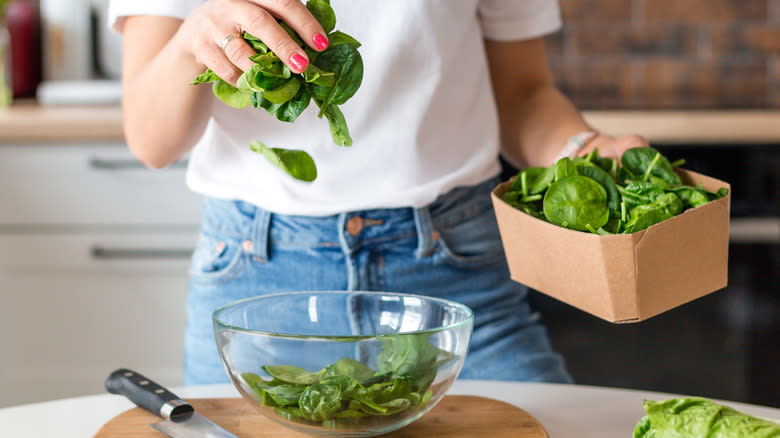Don't Bother Storing Leftover Salad That's Already Been Dressed

Holding onto leftovers is always done with good intentions. After all, why toss the odds and ends of last night's dinner out after you or someone spent so much time preparing it, and the meal will still be perfectly good to eat tomorrow? In addition to helping you to cut back on unnecessary waste, keeping leftovers can even save you the hassle of meal prepping. But unfortunately, not every dish can be saved for another day — we're looking at you, dressed salad.
At the risk of stating the obvious, lettuce can be pretty delicate. Varieties such as ruffled Batavia, velvety Bibb, leafy spring greens, and even crisp Romaine are ready to wilt the moment they're looked at, and once tossed in dressing, their tender structures become weighed down by the heft of oily vinaigrettes and creamy dressings. But, that's just the tip of the iceberg head. The high level of acidity in salad dressings also works to break down lettuce leaves, and in a matter of hours turn slippery and slimy.
Since texture is significantly compromised after being dressed, there's no point in saving leftover salad. However, there are a few things to keep in mind before dumping a bowl into the compost bin.
Read more: 30 Healthy Snack Ideas That Won't Ruin Your Diet
Some Dressed Salads Might Keep Better Than Others

Although you might think that all salads that have been dressed are bin-bound, that's not necessarily the case if you reimagine how to put those leftovers to use. Rather than eat a leftover a salad as is, it might be worthwhile to throw everything into a food processor and blend the it into a dressing for topping other dishes. Alternatively, you could add leftover lettuce inside a sandwich or a quiche.
In contrast, there are instances when you might not even need to worry about wilting as some salads keep better than others. For example, sturdier greens like kale can tolerate dressings, much like recipes void of lettuce. Salads made with vegetables, especially hardy cruciferous options like broccoli, might even benefit from extra time. Bean, pasta, or grain-based salads can also hold up when saved as leftovers as they can soak up moisture without massively impacting texture.
Detest leftovers with a passion? Be more mindful when shopping and cooking. The only way to prevent leftover salad is to dress as much of it as you realistically think you'll eat — we recommend being modest with portions. Additionally, you should store dressing separately, until you're ready to eat. Remember that you can always add more dressing, but you can't remove it. With these helpful tips, you'll look at salads (and how to dress them!) in an entirely new way.
Read the original article on Tasting Table.

 Yahoo Lifestyle
Yahoo Lifestyle 
